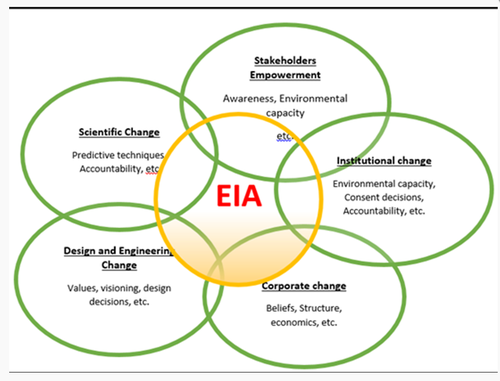Environmental Impact Assessment (EIA) Consulting Firm in Bangladesh.

Environmental Impact Assessment (EIA) Consulting Firm in Bangladesh.
Are you searching Environmental Impact Assessment (EIA) Consulting Firm in Bangladesh? We Ecotechnology is one of the best Environmental Impact Assessment Consultancy Firm in Dhaka, Bangladesh. If you are on that mission, you have landed on just the right place! We are here to help you.
If you are looking a consultancy company, please contact with us. We provide consultancy services all over Bangladesh, specially: Dhaka, Chittagong, Gazipur, Sylhet, Rangpur, Barisal, Khulna and others.
What is Environmental Impact Assessment (EIA)?
Environmental Impact Assessment (EIA) is a process of evaluating the likely environmental impacts of a proposed project or development, taking into account inter-related socio-economic, cultural and human-health impacts, both beneficial and adverse.
UNEP defines Environmental Impact Assessment (EIA) as a tool used to identify the environmental, social and economic impacts of a project prior to decision-making. It aims to predict environmental impacts at an early stage in project planning and design, find ways and means to reduce adverse impacts, shape projects to suit the local environment and present the predictions and options to decision-makers. By using EIA both environmental and economic benefits can be achieved, such as reduced cost and time of project implementation and design, avoided treatment/clean-up costs and impacts of laws and regulations.
Do You Need Environmental Impact Assessment (EIA)?
Call Us: +8801938848623
Objectives of Environmental Impact Assessment (EIA)?
(i) to identify, predict and evaluate the economic, environmental and social impact of development activities
(ii) to provide information on the environmental consequences for decision making and
(iii) to promote environmentally sound and sustainable development through the identification of appropriate alternatives and mitigation measures.
EIA is widely accepted as a tool to ensure sustained development with minimum environmental degradation.
Environmental Impact Statement (EIS) should contain the following information’s/data:
1. Description of proposed action (construction, operation and shut down phase) and selection of alternatives to the proposed action.
2. Nature and magnitude of the likely environmental effects.
3. Possibility of earthquakes and cyclones.
4. Possible effects on surface and ground water quality, soil and air quality.
5. Effects on vegetation, wild life and endangered species.
6. Economic and demographic factors.
7. Identification of relevant human concerns.
8. Noise pollution. Efficient use of inputs.
9. Recycling and reduction of waste.
10. Risk analysis and disaster management.
Main Steps of Environmental Impact Assessment (EIA)?
(1) Screening (usually by an EIA Authority, or using published checklists) – to decide whether an EIA is required.
(2) Consideration of possible alternatives (demand, activity, location, process & design, scheduling, inputs, ‘no project’).
(3) Preliminary assessment – where screening suggests further assessment is needed.
(4) Scoping –a ‘narrowing’ process usually undertaken by an ‘assessment team’ to identify the key issues.
(5) Main EIA study – building on and deepening the preceding steps to predict the extent and magnitude of impacts and determine their significance.
(6) Review – to assess the adequacy of the EIA to decision-making
(7) Monitoring of project implementation and operation
What is included in Environmental Impact Assessment (EIA)?
Environmental Impact Assessment (EIA), Which include mainly Project Background, Purpose of the Environmental Impact Assessment (EIA) Study, Relevant National Policies and Legislation. ECR, Description of the Project, Manufacturing Process, Machineries and Utilities, Raw Materials, ETP, Physico-Chemical, Biological, Socio-economic profile of the project area, Identification of Potential Significant Impacts, Evaluation of Potential Impacts & Mitigation Measures, Environmental Management Plan Outline, Occupational Hazards Management Plan, Environmental Monitoring Program, Monitoring Requirement, Sound / Noise Level, Light, Temperature & Humidity, Stack Emission, Air Quality, Monitoring Indicators, Disaster Management Plan, Six Steps in Emergency Response, Emergency Response and Disaster Management Plan, Environment, Health and Safety (EHS), Conclusion and Recommendation.
Who needs Environmental Impact Assessment (EIA)?
Environmental Impact Assessment (EIA) is required by DoE for Environmental Clearance and other issue, H&M buyer for HIGG index, International Certification body, GSCP, IFC/World Bank, Bangladesh Bank, Govt. BSCI, LEED, BPEI, Sedex, WRAP, ICS, Wal-Mart, Buyers’ Audits, Officers & Various types of Buyer Code of Conduct Audits etc.
Cost of Environmental Impact Assessment (EIA)?
Cost of Environmental Impact Assessment (EIA) is not fixed due to proposed project or development size. Different organization or project or developments may have different size and scope of work. So, budget of Environmental Impact Assessment (EIA) will vary project to project duo to many reason. Price or Project cost is negotiable and depends on project or development complexibility, size, time etc.
Our Other Services:
Ecotechnology is the best Environmental Specialist in Bd. We are HIGG Index Consultant in Bangladesh. We are Environmental Clearance Certificate Consultant in Bangladesh. Ecotechnology is EIA Firm in Bangladesh. Do you need Environmental Management System in Bd. Ecotechnology is Environmental and Social Impact Assessment Specialist in Bangladesh. We provide ISO 14001:2015 Environmental Management System in Bd. Do you need ISO 9001:2015 QMS Certification in Bangladesh. We are ISO 45001: 2018 OHSMS Company in Bangladesh. Ecotechnology is ISO 50001:2018 EMS Certificate Company in Bangladesh. Do you need ISO 22000:2018 Food Safety Management System Consultant in Bd. We are ISO Certificate Provider in Bangladesh. What are Industrial Waste Water Quality Standards in Bangladesh. What is Ambient Air Quality Testing Cost in Bd. What is Industrial Noise / Sound Level Testing Cost in Bd. We are Environmental Analysis Company in Bangladesh. Ecotechnology is ETP Plant Supplier in Bangladesh. What is Water Treatment Plant Price in Bangladesh. Visit for Energy Audit Company in Bangladesh.
